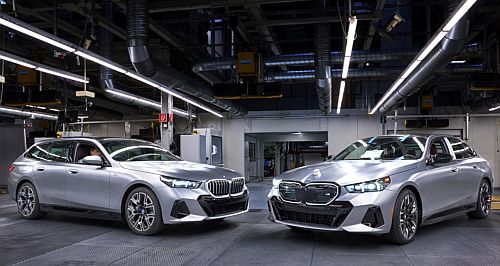Make / Model Search
News - BMWBMW sees continuing role for sedans, wagonsHead BMW Neue Klasse designer says sedans are core to the brand, wagons resurgent22 Sep 2025 By TOM BAKER DESPITE increasing demand for SUVs and taller vehicles, BMW will not abandon traditional sedans or ‘Touring’ station wagons, in part because senior management of the Munich-based company perceives that automotive trends are changing in favour of calmer, less aggressive vehicles.
A commitment to sedans, wagons, low-riding sportscars and an altogether more subtle approach to design was shared with GoAuto by senior BMW designer Oliver Heilmer following the reveal of the second-generation BMW iX3 midsize SUV – the first model based on the Neue Klasse platform (NKP).
Mr Heilmer is one of BMW’s most senior designers with overall responsibility as head of design for compact cars, Neue Klasse models, Mini, and BMW M.
The iX3 debuts the Neue Klasse design language that will spread to 40 models by late 2027, including cars that do not utilise NKP and retain older platforms.
Of these 40 models many will be SUVs, but also a healthy assortment of lower-slung shapes designed not only to appeal to older customers, but also a new class of BMW fans that the brand feels could be on the cusp of rejecting bigger, heavier crossovers.
“It depends on markets,” said Mr Heilmer. “Different markets are reacting differently to proportion. We always try out different kinds of shapes. (BMW) is always testing if the customer’s taste is changing.
“For instance, what we have learned is that the station wagon is becoming more popular in the United States. And then we are reacting (to) it,” he said.
While Northern European and German demand has held up in recent years for BMW’s 3 Series and 5 Series ‘Touring’ wagon line-ups, overwhelming shifts in customer tastes in most world markets have seen estate ranges whittled down in favour of huge expansions in SUVs, including BMW’s X1, X3, X5 and X7.
That could be changing, however. BMW has been particularly surprised by the strength of demand for its new high-performance wagon variants in recent years, with good uptake in the United States and Australia for the M3 Touring, while a plug-in hybrid (PHEV) V8 M5 Touring will hit showrooms in recent months.
Mr Heilmer particularly backed the role of the sedan for BMW, which the design chief sees as truly core to BMW’s DNA.
“A couple of years ago, you might have thought the sedan is something that might disappear,” he said.
“But it’s quite stable to be honest. Now it’s something where we are setting a statement. We have said BMW is standing for sedans. A small, sporty, elegant, midsized sedan is the core of the (BMW) brand.”
BMW’s next model to be revealed will be the i3 sedan. While it revives the dormant badge of an experimental hatchback, the new model is a 3 Series sedan with a BEV powertrain, featuring Neue Klasse design language and using NKP.
Internal combustion (ICE) versions of the 3 Series will also be released with Neue Klasse design, but with a development of the Cluster Architecture (CLAR) platform used on the outgoing G20-generation 3 Series.
There will also be a battery electric i3 Touring, plus ICE and BEV versions of the high-performance M3.
The i3 will echo the new iX3 in adopting surprisingly small kidney grilles. The SUV model experienced a marked downsize in grille size compared to its last generation while the M3 models are expected to ditch the oversize vertical grille design showcased on the G80/G81 generation.
“That was a representation of the trend at the time,” Mr Heilmer explained. “When we introduced the (G80) M3’s vertical kidneys, customers really appreciated the differentiation. It was the right approach.
“But times are changing. Everything is becoming more calm. It doesn’t have to be too in-your-face in terms of expression. It can be way more subtle. That is, maybe, the era we are in from a BMW perspective. We are talking about monolithic, clean surfaces – calm, but still highly emotional.”
Mr Heilmer said the kidney grille itself was an essential part of BMW design which will not go away. However, the designer acknowledged that BMW would play with size and scale of the kidneys, plus the Hofmeister kink daylight opening design, depending on a model’s size and role.
“We have a broad range of products at BMW. If there will be a (model) in future that we feel, in terms of presence, we are going to need a bigger representation of the kidney, we will do it,” Mr Heilmer said.
“But the core of the brand, the iX3, i3, is closer to (a) reference to what we had in the ’60s, where we said it doesn’t have to be that ‘loud’ for this type of car.”
Meanwhile, real air intakes will continue to be designed into the facias of high-performance models, with Mr Heilmer reflecting that powerful ICE models still need to breathe.
However, there are other elements BMW enthusiasts love that are not currently pegged to make a return – including circular headlights, with Mr Heilmer stating that the development of LED lighting technology negating the historical reasons for headlights to be round.
“We always try to find a nice combination between iconography and technology. At the moment, we are playing with different [lighting] shapes but not round ones,” Mr Heilmer said.
“But you never know. There are waves where something is trending and it might happen, but we don’t plan it at the moment.
“At the end, it’s about brand confidence. The bigger risk we see is if we are going to copy something trending…the risk is high that we will lose part of our DNA,” Mr Heilmer said.  Read more |
Click to shareBMW articlesResearch BMW Motor industry news |










Facebook Twitter Instagram